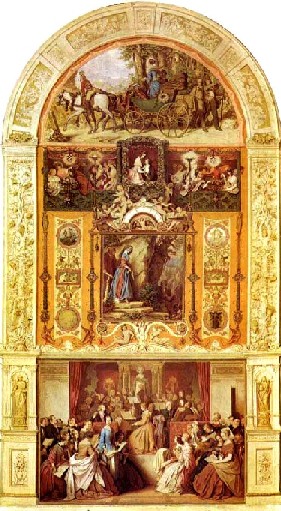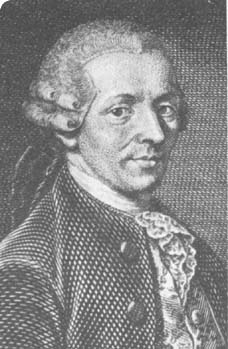 "Die Symphonie" (The Symphony) (by Moritz v. Schwind) |
 |
Haydn |
With nearly 40 years of symphonic activity, Haydn's activity outranks that of most of his contemporary colleagues. Modern Haydn scholars point out that he had not only written 104, but rather 106 symphonies. Grove argues that it is difficult to arrive at clearly defined creative style periods in Haydn's work, since the similarities between Haydn works of a certain time span are less noticeable than their differences and peculiarities. In general, so Grove, his works reflect the outer circumstances in which they were written. As a young man, he worked and wrote for smaller ensembles and orchestras. This, reports Grove, is also reflected in his symphonies, although a basic tendency can already be discerned in his first, overture-style symphony no. 1 from about 1757 - 1758. During this time, and during his first years of service with Prince Esterhazy (from 1761 on) Haydn wrote in a greater variety of styles and at any other time. This variety also included symphonies with generously conceived concert elements, canons, fugue-style final movements and reminiscences of the church sonata and its "Cantus Firmus" techniques. Grove points out that this variety should not only be seen from the viewpoint of Haydn's interest in experimentation, but also as a response to the most varied practical demands on him, such as, for example, the performance of one or the other of his symphonies in a church. Also in his later years, reports Grove, Haydn has reacted to special demands with unusually inventive solutions, as, for example, in his humorous Symphony no. 60 of about 1774 ('Il distratto'), the six movements of which he had initially written as occasional music for a comedy, or in his Symphony no. 31 of 1765 ('Das Hornsignal'), an excellent example of his 'concert' style, into which he incorporated various horn signals, whereby, however, the title of the work, as happens very often, did not originate with the composer. |
Grove reports that Haydn's early symphonies appeared to prefer the three-movement style, although, already at that time, the composer displayed more interest in the last movements of his symphonies than was usual in the opera overtures of that time. Gradually, Haydn moved on to the use of the four-movement style which we had already discussed in our section on Vienna: fast-minuet/trio-slow-fast, in his Symphonies no. 32, 37 and 108 from 1757 - 1762, later also in his Symphonies no. 44 uad 68, fast-slow-minuet/trio-fast, in his Symphonies no. 5, 11, 21, 22 and 34 from around 1760 - 1764, and later also in his Symphony no. 49; and finally the standard cycle of fast-slow-minuet/trio-fast of his later years, in his Symphonies no. 3, and 6 - 8 (the trilogy 'Le Matin', 'Le Midi' and 'Le Soir'), as well as in no. 14, 20, 33 and 36 from about 1758 - 1762. His Symphonies no. 6 and 7 are two of the earliest that consist of four movements and that begin with a slow introduction, whereby the introduction to no. 6, 'Le Matin', represents a somewhat abbreviates sun rise (see also no. 25 of about 1760 - 1761), in which the expanded slow introduction, which, according to Grove, is connected to the independent adagio movements of the same time, is followed by a fast-minuet/trio-fast sequence of three movements). However, reports Grove, Haydn re-applied this pattern only in the 1770's, in his Symphonies no. 50, 53, 54 and 57 of 1773 - 1774 and in his Symphonies no. 71, 73 and 75 from about 1778 - 1781, and only from 1785 on did he make regular use of it. In his later creative years, reports Grove, Haydn, on a large basis, worked on various nuances and and novelties which would become important to his successors. These include the slow introduction and the following fast movement in his Symphonies mo. 90, 98 and 102 - 103, the development and application of a number of forms of variations in slow movements (beginning with his Symphonies no. 53, 63 and 70 in the late 1770's) and effective combinations of the variation, rondo and sonata principles; the combination of minuet and trio by means of a transition after the trio (such as in his Symphonies no. 50, 99 and 104); and the frequent use of final movements in sonata-rondo-combinations (according to Grove, the best known examples for this can be found in his Symphonies no. 80, 94, 99 and 101 - 103). Haydn's service under Prince Esterhazy demanded of him that he constantly wrote symphonies for immediate performance, which provided him with unique opportunities for creativity and self-criticism. Grove explains that within this framework, Haydn worked on further internal expansion, such as, for example, on that of his musical themes, on new means for musical development, on the exploration of remote keys, and that he, with often not more than 20 musicians at his disposal, often achieved very surprising sound effects. As Grove argues, the surprisingly large number of excellent symphonies that he composed shows numerous characteristic traits, amongst which can, for example, be found his capability of writing his expositions out of a single thematic idea, whereby the contrast was often set towards the end, his constant exploitation of the unexpected, unpredictable, since in each of his works, the surprise effect is based on another idea, and the creation of a clear zenith which lent musical development a particular profile. Of great importance, argues Grove, are two apparently opposing processes, namely expansion and contraction. Grove further reports that many biographers noted a "Sturm und Drang" (storm and stress) period in Haydn's creative life during the second half of the 1760's and in the early 1770's. 'Sturm und Drang' is certainly recognizeable in his impressive Symphonies in minor key of that time, no. 26, 39, 44, 45, 49 and 52; however, argues Grove further, this somewhat superficial approach overlooks the fact that symphonies in minor keys were in the minority in Haydn's creative output of that time, as well. Further, the implied relationship between Haydn's alleged 'musical' storm and stress and the style period in German literature stands on somewhat shaky chronological ground, since the literary style period is mainly attributed to the middle of the 1770's and later, thus after Haydn had made his alleged contributions to this musical style. |
From 1776 on, reports Grove, Haydn's symphonic work, perhaps on the basis of his new duties in operatic work, had declined somewhat, and some works, in spite of all of their symphonic mastery, appear to be of a more neutral character. However, in this period that many musicologists describe as negative, the style of Haydn's later symphonies emerged, with his insertion of slow variation movements, last movements in rondo style, and sophisticated new approaches with respect to texture, harmony, form and orchestration. These works, argues Grove, also showed various connections to stage and opera, as, for example, his Symphonies no. 50, 53, 60, 62, 63, 73 and possibly also no. 67, which contained movements from his opera overtures. Grove describes the period of 1785 - 1795 as the zenith of Haydn's symphonic creativity. A commission from Paris led to the composition of six new symphonies, his Symphonies no. 82 - 87, the 'Paris' Symphonies (for the 'Concert de la Loge Olumpique), followed by his Symphonies no. 88 and 89 in 1787, his 'Tost' Symphonies no. 90 - 92 and his 'Oettingen-Wallerstein'-Symphonies from 1788. In these works, reports Grove, Haydn reached new heights of creativity, humor and candidly applied intellect, and, with respect to the latter, particularly with respect to development and thematic coherence. His two journeys to England, from 1791 - 1792 and from 1795 - 1795, had brought forth six new symphonies each, namely no. 93 - 98 and no. 98 - 104. According to Grove, these symphonies also surpassed those from the 1780's in breadth of conception, melodic beauty, orchestral splendour and majestic dignity, which, however, never appeared artificial or awkward. |
In conclusion, Grove described Haydn as an innovator in all musical areas. Thus, nearly every symphony of his contains a variety of ideas that successfully works against their thematic classification. Two kinds of techniques which Haydn repeatedly applied, yet constantly changed, allow us some insight into Haydn's method. On the one hand, through the treatment of the phrase as part of larger rythimic groupings instead of as actual goals, he achieved a broad rhythmic control, to which also contributed his transition techniques that he often applied. On the other hand, in the sonata form, through the expansion of the development process, with the inclusion of exposition and recapitulation, he demonstrated revolutionary possibilities . According to Grove, both of these concepts subsequently strongly influenced Beethoven. According to Grove, Haydns inventiveness, can only be hinted at by using examples; however, it can not be reflected in its entirety. Some of these examples include his famous, dynamic surprise effects, such as the 'tutti'-section in the slow movement of his Symphony no. 94, or his characteristic drum-roll repetitions of first themes, that, however, went beyond the framework of mere effect, in order to hint at structure and to liven the rhythmic flow, which are, in turn, goals that can be identified in details such as the frequent use of the crossing of accents, which Beethoven would also later make use of. By the same token, his famous last movements, in which the number of orchestra members slowly decreases, such as in his 'Farewell Symphony' no. 45 (of 1772), point to Haydn's interest in the coherence of the symphonic cycle. Grove further reports that in his orchestration, Haydn applied many fresh sounds, including that of the kettle drum in the introduction (no. 103), English horns instead of oboes (no. 22), contrabass solos (in the trios of no. 6 -8, and in the final movements of no. 72, 31 and 45, 'Turkish' music (no. 100), and four concert-style horns (no. 72 and 31). The many solos for strings and wind instruments were even, in the center of the 'symphonie concertante', in Paris, considered as exemplary. Haydn's tonal range is considered to be the broadest of the 18th century, continues Grove, and in contrast to the myth of the 'humoresque' Haydn one should not forget that he actually wrote more symphonies in a minor key than most 18th-centruy composers (with the exception of Vanhal, Beck and Gossec). The tonal relationships in his symphonies are reported as being less daring than in his piano sonatas and his chamber music, although the second, G Major movement of his Symphony in B Major must have had a surprising effect in his time. Within the movements of his symphonies, certain modulations reached into remoted tonal areas in a new manner, with which Haydn prepared the way for Beethoven and Schubert. Haydn's attention to structure might have led to a lesser emphasis of the melody, and in spite of his use of many attractive themes, he impresses us more with his motivic development than with the originality of beauty of his original material. Many of Haydn's themes were already motivically exploited in their first use. Thus, the so-called folksiness of his themes can be traced back rather to a specific kind of thematic development than to their origin in folk music. Haydn's strong, extended transitions also contained considerable development work, and also his frequent 'mono-thematic' expositions, in which the second theme presents the first theme in a new fashion or is derived from the first theme, can be considered as examples of his work in musical development. |
Source: |